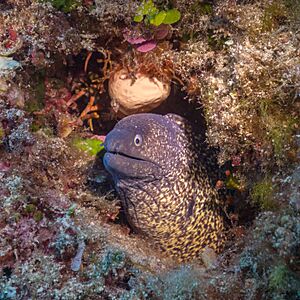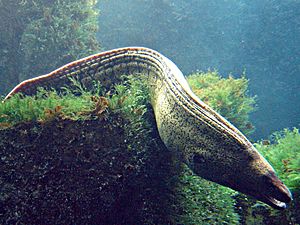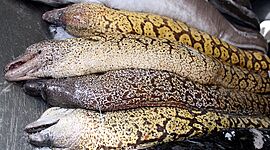Mediterranean moray facts for kids
The Mediterranean moray (Muraena helena), also known as the Roman eel, is a fascinating fish that belongs to the moray eel family. It has a long body, much like an eel, and can be found in the eastern part of the Atlantic Ocean and throughout the Mediterranean Sea. While beautiful, it's important to know that its bite can be dangerous to humans.
Quick facts for kids Mediterranean moray |
|
|---|---|
 |
|
| Conservation status | |
| Scientific classification | |
| Synonyms | |
|
List
|
Contents
Appearance and Features

The Mediterranean moray has a long, snake-like body. It can grow up to about 5 feet (1.5 meters) long and weigh more than 33 pounds (15 kilograms). Its skin is usually dark grey to dark brown and covered with small dark spots. It feels slimy and does not have scales.
The fin on its back, called the dorsal fin, starts right behind its head. It runs all the way to its tail fin, which is joined with the fin on its underside (anal fin). Unlike many fish, it doesn't have pectoral fins, which are usually found behind the gills. Its teeth are long and very sharp, just like other moray eels. The mouth is large and strong, reaching back past its gills.
Where They Live and What They Do
The Mediterranean moray lives in the coastal waters of the eastern Atlantic Ocean. You can find them from the British Isles all the way down to the coast of Senegal. They also live around the Canary Islands, the Azores, and throughout the Mediterranean Sea.
These eels prefer to live on rocky seabeds. They can be found in waters from about 16.5 feet (5 meters) deep to 264 feet (80 meters) deep. The Mediterranean moray is a solitary animal, meaning it likes to be alone. It is also very territorial, defending its home area.
During the day, the moray spends most of its time hiding in caves or cracks between rocks. It becomes much more active at night. It hunts for fish, crabs, and squid. It will also eat dead animals it finds.
Reproduction and Life Cycle
Scientists don't know a lot about how the Mediterranean moray reproduces. When they spawn, they release about 60,000 eggs into the open water. From these eggs, tiny, clear larvae called leptocephali hatch. These larvae float in the ocean as part of the plankton.
Morays and Humans
The bite of a Mediterranean moray can be painful. This is mainly because of a mildly toxic slime on its skin. However, these eels are sometimes caught for food. People cook them fresh by broiling, boiling, or baking them. The skin of the moray can also be used to make leather.



